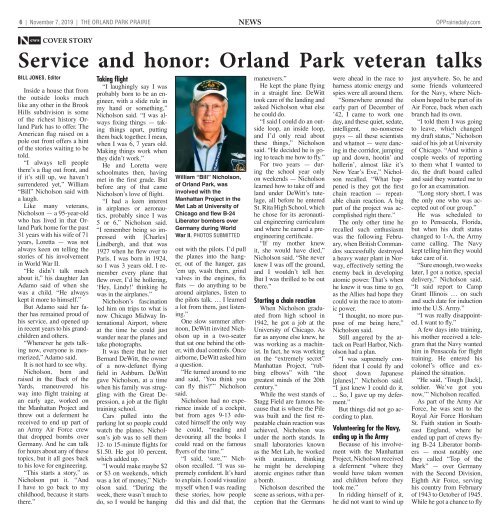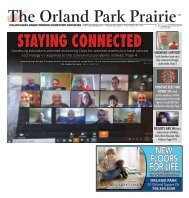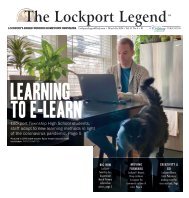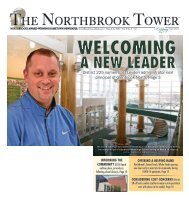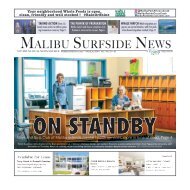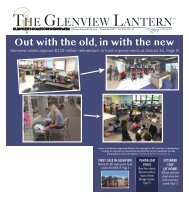OP_110719
OP_110719
OP_110719
You also want an ePaper? Increase the reach of your titles
YUMPU automatically turns print PDFs into web optimized ePapers that Google loves.
6 | November 7, 2019 | the orland Park Prairie news<br />
<strong>OP</strong>Prairiedaily.com<br />
Service and honor: Orland Park veteran talks<br />
Bill Jones, Editor<br />
Inside a house that from<br />
the outside looks much<br />
like any other in the Brook<br />
Hills subdivision is some<br />
of the richest history Orland<br />
Park has to offer. The<br />
American flag raised on a<br />
pole out front offers a hint<br />
of the stories waiting to be<br />
told.<br />
“I always tell people<br />
there’s a flag out front, and<br />
if it’s still up, we haven’t<br />
surrendered yet,” William<br />
“Bill” Nicholson said with<br />
a laugh.<br />
Like many veterans,<br />
Nicholson — a 95-year-old<br />
who has lived in that Orland<br />
Park home for the past<br />
31 years with his wife of 71<br />
years, Loretta — was not<br />
always keen on telling the<br />
stories of his involvement<br />
in World War II.<br />
“He didn’t talk much<br />
about it,” his daughter Jan<br />
Adamo said of when she<br />
was a child. “He always<br />
kept it more to himself.”<br />
But Adamo said her father<br />
has remained proud of<br />
his service, and opened up<br />
in recent years to his grandchildren<br />
and others.<br />
“Whenever he gets talking<br />
now, everyone is mesmerized,”<br />
Adamo said.<br />
It is not hard to see why.<br />
Nicholson, born and<br />
raised in the Back of the<br />
Yards, maneuvered his<br />
way into flight training at<br />
an early age, worked on<br />
the Manhattan Project and<br />
threw out a deferment he<br />
received to end up part of<br />
an Army Air Force crew<br />
that dropped bombs over<br />
Germany. And he can talk<br />
for hours about any of these<br />
topics, but it all goes back<br />
to his love for engineering.<br />
“This starts a story,” as<br />
Nicholson put it. “And<br />
I have to go back to my<br />
childhood, because it starts<br />
there.”<br />
Taking flight<br />
“I laughingly say I was<br />
probably born to be an engineer,<br />
with a slide rule in<br />
my hand or something,”<br />
Nicholson said. “I was always<br />
fixing things — taking<br />
things apart, putting<br />
them back together. I mean,<br />
when I was 6, 7 years old.<br />
Making things work when<br />
they didn’t work.”<br />
He and Loretta were<br />
schoolmates then, having<br />
met in the first grade. But<br />
before any of that came<br />
Nicholson’s love of flight.<br />
“I had a keen interest<br />
in airplanes or aeronautics,<br />
probably since I was<br />
5 or 6,” Nicholson said.<br />
“I remember being so impressed<br />
with [Charles]<br />
Lindbergh, and that was<br />
1927 when he flew over to<br />
Paris. I was born in 1924,<br />
so I was 3 years old. I remember<br />
every plane that<br />
flew over, I’d be hollering,<br />
‘Hey, Lindy!’ thinking he<br />
was in the airplanes.”<br />
Nicholson’s fascination<br />
led him on trips to what is<br />
now Chicago Midway International<br />
Airport, where<br />
at the time he could just<br />
wander near the planes and<br />
take photographs.<br />
It was there that he met<br />
Bernard DeWitt, the owner<br />
of a now-defunct flying<br />
field in Ashburn. DeWitt<br />
gave Nicholson, at a time<br />
when his family was struggling<br />
with the Great Depression,<br />
a job at the flight<br />
training school.<br />
Cars pulled into the<br />
parking lot so people could<br />
watch the planes. Nicholson’s<br />
job was to sell them<br />
12- to 15-minute flights for<br />
$1.50. He got 10 percent,<br />
which added up.<br />
“I would make maybe $2<br />
or $3 on weekends, which<br />
was a lot of money,” Nicholson<br />
said. “During the<br />
week, there wasn’t much to<br />
do, so I would be hanging<br />
William “Bill” Nicholson,<br />
of Orland Park, was<br />
involved with the<br />
Manhattan Project in the<br />
Met Lab at University of<br />
Chicago and flew B-24<br />
Liberator bombers over<br />
Germany during World<br />
War II. Photos submitted<br />
out with the pilots. I’d pull<br />
the planes into the hanger,<br />
out of the hanger, gas<br />
’em up, wash them, grind<br />
valves in the engines, fix<br />
flats — do anything to be<br />
around airplanes, listen to<br />
the pilots talk. … I learned<br />
a lot from them, just listening.”<br />
One slow summer afternoon,<br />
DeWitt invited Nicholson<br />
up in a two-seater<br />
that sat one behind the other,<br />
with dual controls. Once<br />
airborne, DeWitt asked him<br />
a question.<br />
“He turned around to me<br />
and said, ‘You think you<br />
can fly this?’” Nicholson<br />
said.<br />
Nicholson had no experience<br />
inside of a cockpit,<br />
but from ages 9-13 educated<br />
himself the only way<br />
he could, “reading and<br />
devouring all the books I<br />
could read on the famous<br />
flyers of the time.”<br />
“I said, ‘sure,’” Nicholson<br />
recalled. “I was supremely<br />
confident. It’s hard<br />
to explain. I could visualize<br />
myself when I was reading<br />
these stories, how people<br />
did this and did that, the<br />
maneuvers.”<br />
He kept the plane flying<br />
in a straight line. DeWitt<br />
took care of the landing and<br />
asked Nicholson what else<br />
he could do.<br />
“I said I could do an outside<br />
loop, an inside loop,<br />
and I’d only read about<br />
these things,” Nicholson<br />
said. “He decided he is going<br />
to teach me how to fly.”<br />
For two years — during<br />
the school year only<br />
on weekends — Nicholson<br />
learned how to take off and<br />
land under DeWitt’s tutelage,<br />
all before he entered<br />
St. Rita High School, which<br />
he chose for its aeronautical<br />
engineering curriculum<br />
and where he earned a preengineering<br />
certificate.<br />
“If my mother knew<br />
it, she would have died,”<br />
Nicholson said. “She never<br />
knew I was off the ground,<br />
and I wouldn’t tell her.<br />
But I was thrilled to be out<br />
there.”<br />
Starting a chain reaction<br />
When Nicholson graduated<br />
from high school in<br />
1942, he got a job at the<br />
University of Chicago. As<br />
far as anyone else knew, he<br />
was working as a machinist.<br />
In fact, he was working<br />
on the “extremely secret”<br />
Manhattan Project, “rubbing<br />
elbows” with “the<br />
greatest minds of the 20th<br />
century.”<br />
While the west stands of<br />
Stagg Field are famous because<br />
that is where the Pile<br />
was built and the first repeatable<br />
chain reaction was<br />
achieved, Nicholson was<br />
under the north stands. In<br />
small laboratories known<br />
as the Met Lab, he worked<br />
with uranium, thinking<br />
he might be developing<br />
atomic engines rather than<br />
a bomb.<br />
Nicholson described the<br />
scene as serious, with a perception<br />
that the Germans<br />
were ahead in the race to<br />
harness atomic energy and<br />
spies were all around them.<br />
“Somewhere around the<br />
early part of December of<br />
’42, I came to work one<br />
day, and these quiet, sedate,<br />
intelligent, no-nonsense<br />
guys — all these scientists<br />
and whatnot — were dancing<br />
in the corridor, jumping<br />
up and down, hootin’ and<br />
hollerin’, almost like it’s<br />
New Year’s Eve,” Nicholson<br />
recalled. “What happened<br />
is they got the first<br />
chain reaction — repeatable<br />
chain reaction. A big<br />
part of the project was accomplished<br />
right there.”<br />
The only other time he<br />
recalled such enthusiasm<br />
was the following February,<br />
when British Commandos<br />
successfully destroyed<br />
a heavy water plant in Norway,<br />
effectively setting the<br />
enemy back in developing<br />
atomic power. That’s when<br />
he knew it was time to go,<br />
as the Allies had hope they<br />
could win the race to atomic<br />
power.<br />
“I thought, no more purpose<br />
of me being here,”<br />
Nicholson said.<br />
Still angered by the attack<br />
on Pearl Harbor, Nicholson<br />
had a plan.<br />
“I was supremely confident<br />
that I could fly and<br />
shoot down Japanese<br />
[planes],” Nicholson said.<br />
“I just knew I could do it.<br />
... So, I gave up my deferment.”<br />
But things did not go according<br />
to plan.<br />
Volunteering for the Navy,<br />
ending up in the Army<br />
Because of his involvement<br />
with the Manhattan<br />
Project, Nicholson received<br />
a deferment “where they<br />
would have taken women<br />
and children before they<br />
took me.”<br />
In ridding himself of it,<br />
he did not want to wind up<br />
just anywhere. So, he and<br />
some friends volunteered<br />
for the Navy, where Nicholson<br />
hoped to be part of its<br />
Air Force, back when each<br />
branch had its own.<br />
“I told them I was going<br />
to leave, which changed<br />
my draft status,” Nicholson<br />
said of his job at University<br />
of Chicago. “And within a<br />
couple weeks of reporting<br />
to them what I wanted to<br />
do, the draft board called<br />
and said they wanted me to<br />
go for an examination.<br />
“Long story short, I was<br />
the only one who was accepted<br />
out of our group.”<br />
He was scheduled to<br />
go to Pensacola, Florida,<br />
but when his draft status<br />
changed to 1-A, the Army<br />
came calling. The Navy<br />
kept telling him they would<br />
take care of it.<br />
“Sure enough, two weeks<br />
later, I got a notice, special<br />
delivery,” Nicholson said.<br />
“It said report to Camp<br />
Grant Illinois … on such<br />
and such date for induction<br />
into the U.S. Army.”<br />
“I was really disappointed.<br />
I want to fly.”<br />
A few days into training,<br />
his mother received a telegram<br />
that the Navy wanted<br />
him in Pensacola for flight<br />
training. He entered his<br />
colonel’s office and explained<br />
the situation.<br />
“He said, ‘Tough [luck],<br />
soldier. We’ve got you<br />
now,’” Nicholson recalled.<br />
As part of the Army Air<br />
Force, he was sent to the<br />
Royal Air Force Horsham<br />
St. Faith station in Southeast<br />
England, where he<br />
ended up part of crews flying<br />
B-24 Liberator bombers<br />
— most notably one<br />
they called “Top of the<br />
Mark” — over Germany<br />
with the Second Division,<br />
Eighth Air Force, serving<br />
his country from February<br />
of 1943 to October of 1945.<br />
While he got a chance to fly


